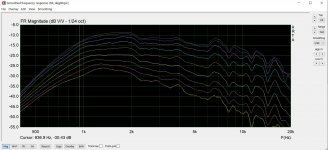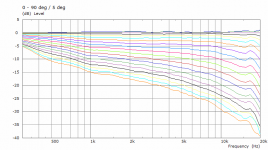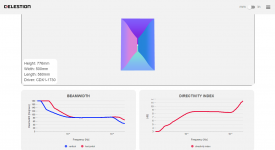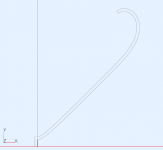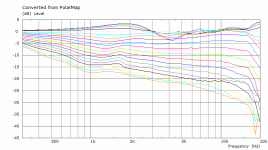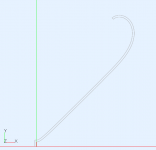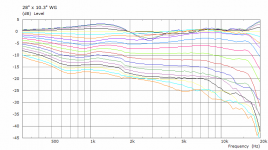From Mäkvirta's book (Genelec):
Loudspeakers with wide bandwidth, flat and smooth magnitude response, and uniformly wide directivity are generally rated high by experienced listeners (Olive, 2003).
> There's no rating system for DI. The Ultra Salon2 has been considered a benchmark for over a decade. Its DI, while very good, isn't perfect.
Rotating the loudspeaker around its horizontal and vertical planes on a turntable and measuring the frequency responses can obtain a more accurate understanding of directivity. It is important to rotate the loudspeaker around its acoustic and not the mechanical center. These two may not coincide. If the loudspeaker is rotated around its mechanical center, there will be a direction-related error.
Modern measurement and modeling methods produce detailed data on loudspeaker performance. Yet we lack a method to map this information to the listener’s experience. The subjective quality judgments relate to the main categories of flatness of the frequency response, quality and accuracy of virtual imaging, and lack of distortion or extraneous noises during operation. A loudspeaker is expected not to color the sound even when used in a reverberant room. Virtual sound images constructed between loudspeakers are expected to be precise and well defined (not stretched or blurred). The loudspeaker is expected to be able to reproduce the whole dynamic range in the sound recording without detectable increase in distortion at high output levels and without producing extraneous sounds. Although discussion about listening tests goes beyond the scope of this article, the importance of first-hand listening testing can never be overemphasized.
Loudspeakers with wide bandwidth, flat and smooth magnitude response, and uniformly wide directivity are generally rated high by experienced listeners (Olive, 2003).
> There's no rating system for DI. The Ultra Salon2 has been considered a benchmark for over a decade. Its DI, while very good, isn't perfect.
Rotating the loudspeaker around its horizontal and vertical planes on a turntable and measuring the frequency responses can obtain a more accurate understanding of directivity. It is important to rotate the loudspeaker around its acoustic and not the mechanical center. These two may not coincide. If the loudspeaker is rotated around its mechanical center, there will be a direction-related error.
Modern measurement and modeling methods produce detailed data on loudspeaker performance. Yet we lack a method to map this information to the listener’s experience. The subjective quality judgments relate to the main categories of flatness of the frequency response, quality and accuracy of virtual imaging, and lack of distortion or extraneous noises during operation. A loudspeaker is expected not to color the sound even when used in a reverberant room. Virtual sound images constructed between loudspeakers are expected to be precise and well defined (not stretched or blurred). The loudspeaker is expected to be able to reproduce the whole dynamic range in the sound recording without detectable increase in distortion at high output levels and without producing extraneous sounds. Although discussion about listening tests goes beyond the scope of this article, the importance of first-hand listening testing can never be overemphasized.
Last edited:
The best speakers I know do not always score very high on DI, but they do wrt room integration.
The reason for my interest in radiation impedance has of course to do with loading. My final horn will initially be used in a straightforward 2-way configuration, but preferably should also be suitable for a (much) bigger (also 2 way) system in the future.
I therefore look forward to the measurements of the HF1440 with "the beast".
The reason for my interest in radiation impedance has of course to do with loading. My final horn will initially be used in a straightforward 2-way configuration, but preferably should also be suitable for a (much) bigger (also 2 way) system in the future.
I therefore look forward to the measurements of the HF1440 with "the beast".
Competition here... 
Celestion Introduces HornWizard App for High Frequency Horn Design | audioXpress
But beware.. it's server side comp so they will see your input...
//
Celestion Introduces HornWizard App for High Frequency Horn Design | audioXpress
But beware.. it's server side comp so they will see your input...
//
Last edited:
It is the case with the newest axisymmetric designs by they also have tilted power response, i.e. rising DI a bit. It seems that as one tries to make the DI really constant the axial ripple and narrowing and widening start to appear no matter what. My explanation is that the (almost) conical profile needed for the "real" constant directivity is difficult to terminate as smoothly in a resonably finite size - seems logical after all. Once it is curved all the way along, even if only a little, it's much easier but also the DI rises. That said, I'm still not sure that the mildly rising DI with a flat direct response are a bad thing.
I know that this is your opinion and I have tried to be clear about my differences all along. What you say is almost certainly the case when one places size as a constraint, but for larger waveguides I have found that it is not true. What "reasonably finite size" means is relative and I understand that for many it is a very real constraint, but it has not been for me. Larger systems can yield a higher and flatter DI than is achievable with smaller systems. This, to me, is an advantage and so my systems are large. Given the size constraint, I can agree with you, but going larger means less constraints and better performance.
I think we already had a similar conversation and I think I can also restate my opinion clearly now - I tend to believe that this 15" WG would be prefered in a blind test over e.g. the 18" waveguide in your largest system. Maybe even the 12" above would do it. I really believe this because of the improved smoothness/absence of almost any diffraction. I can be wrong, of course, but that's how I see it.
Last edited:
Don't you think the same?
No, I didn't then and I don't really now. To me none of these waveguide will have enough diffraction that the listening window cannot be effectively EQ'd. Then we come to the DI. A larger device can have a higher DI and that to me is very important, and its flatness can also quite good. You put emphasis in different places than I do, so yes, we will disagree on the fringes.
How do you know that? There are much finer details than these that can be heard. Everyone who ever "tuned" a crossover, for example, and listened to it immediately, really knows what I'm talking about - sometimes a difference of 0.5 dB make substantial difference in the sound. Then speaking of a tolerance, like +-2 dB, for example, is pretty much useless when it comes to frequency response(s). These are so different results to me... OK, maybe I'm the only one here 
You aren't the only oneThese are so different results to me... OK, maybe I'm the only one here
I mean, talking about listening window equalization - how wide angle is that supposed to be? With the more variable responses shown above there can be up to several dB differences at different frequencies across that window. You just have to be lucky to sit where there's the best balance. How that can be a better performer?
Thanks, I really wasn't sure if you still hold this position. All right.
28" WG
You are not optimizing the shape for the situation. That is a very poor example.
My statement was perhaps a bit provocative and oversimplified.
A big OS waveguide with a proper termination shouldn't perform completely different from a similar ATH4 waveguide, off-axis (as originally intended).
The latter is undoubtedly better in the end.
My point is that for the time being we mainly look at simulations. The response of real horns with real drivers can easily differ from the simulated plots, as the horn-driver interface is only approximately simulated using a hypothetical driver.
A big OS waveguide with a proper termination shouldn't perform completely different from a similar ATH4 waveguide, off-axis (as originally intended).
The latter is undoubtedly better in the end.
My point is that for the time being we mainly look at simulations. The response of real horns with real drivers can easily differ from the simulated plots, as the horn-driver interface is only approximately simulated using a hypothetical driver.
Last edited:
- Home
- Loudspeakers
- Multi-Way
- Acoustic Horn Design – The Easy Way (Ath4)
